Govardhan Ecovillage: A Longing Fulfilled
by Gauranga Darshan Das
This Krishna-centered village in India’s Sahyadri mountains arose from the desire to fulfill one of Srila Prabhupada’s primary aims for his movement.
The vision for Govardhan Ecovillage, and the manifestation of that vision.

In March 2010 Radhanath Swami asked a group of young men – some his disciples, some soon to be – to move from ISKCON’s Sri Sri Radha-Gopinatha temple in Chowpatty, Mumbai, to Govardhan Ecovillage, 108 kilometers from Mumbai, to develop a farm project there. It was his ardent desire to fulfill the dream of his beloved guru, His Divine Grace A. C. Bhaktivedanta Swami Prabhupada, by developing this farm community centered on spiritual principles.
Later, in December 2010, he spoke to these devotees before leaving for the annual pilgrimage he leads for a large group of devotees.
“While you are doing work here,” he told the Govardhan Ecovillage team, “I will be praying for you during the pilgrimage. We will be visiting holy places, and you will be creating a holy place.”
Srila Prabhupada’s Desire

ISKCON’s first farm community is in Moundsville, West Virginia. Srila Prabhupada went there for the first time on May 21, 1969. He had numerous ideas about how to develop the place as a replica of Vrindavan Dhama.
In a letter to Hayagriva Dasa (March 1968), Srila Prabhupada wrote, “I am so glad to learn that one gentleman is going to open an ashram in the West Virginia, and he has secured a big tract of land, 320 acres, and I wish that this tract of land may be turned into New Vrindaban. You have New York, New England, and so many “New” duplicates of European countries in the USA; why not import New Vrindaban in your country?”
In letters to Hayagriva, Kirtanananda Swami, and others between 1968 and 1973, Srila Prabhupada shared his vision for New Vrindaban and emphasized its vital aspects: cow protection, agriculture, simple village life, a place of pilgrimage (a replica of Vrindavan), a place of higher learning, and ultimately a place for people to develop their love for Krishna.

A Step Toward Fulfilling the Vision
One of the purposes of ISKCON that Srila Prabhupada had listed on its founding documents was “To erect for the members and for society at large a holy place of transcendental pastimes, dedicated to the personality of Krishna.” Radhanath Swami had been longing for decades to fulfill Srila Prabhupada’s desires in this regard, and he inspired the devotees at ISKCON Chowpatty to work in that direction.
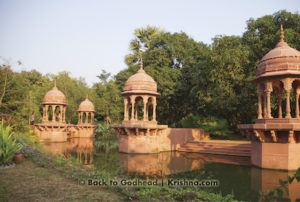
Expressing his eagerness and emphasizing the urgency of the project, Radhanath Swami told the devotees in 2009, “Now our number one priority is developing the farm community. We want to put our best men and resources to develop this project into a wonderful place where we can demonstrate to the whole world the glories of protecting cows and living with respect for and harmony with Mother Earth.”
He wanted the project to be eco-friendly, which he explained meant living in harmony with nature and according to the way Krishna wants us to live materially and spiritually, and living with respect for Mother Earth, Bhumi Devi, the consort of Lord Varahadeva.
“She is Lakshmi herself,” he explained, “and we must honor her and live in ways that replenish her resources rather than exploit them. We must use whatever resources she gives us, by her grace, for the service of Lord Vishnu.”

Govardhan Ecovillage (GEV) is situated in the lush green Sahyadri mountain range, close to the Vaitarna River in the Palghar district of Maharashtra. Spread over 140 acres, it is home to several eco-friendly initiatives.
Sanat-kumara Dasa, the director of rural development and co-president of ISKCON Chowpatty; Rupa Raghunatha Dasa, the head of the rural outreach section; Sri Nandanandana Dasa, the head of the cow-care section; and Venudhari Dasa, a rural preacher, moved to GEV in 2003. These pioneer residents initiated various projects that made steady progress in the early years, including organic farming, cow care, spiritual outreach in the villages, and an orphanage and school for underprivileged rural children.
In 2009 GEV began its focus on the development of a spiritual retreat center. Gauranga Dasa, the director of strategy and communications, and Vasudeva Dasa, the director of administration and sustainability, began research on various eco-centers in India and found an eco-friendly technology – compressed stabilized earth blocks – for making green buildings, and built the first guesthouse.

In June 2010, on Radhanath Swami’s request (mentioned in the opening paragraph), fifteen young brahmacharis moved from Chowpatty to GEV, and full-scale development of various facilities began. They included an Ayurvedic wellness center, guestrooms, a satsanga bhavan (“spiritual assembly building”) with an auditorium, seminar halls, conference rooms, and more. Devarshi Narada Dasa and Sarvatma Hari Dasa coordinated most of the construction.
Various Features at Govardhan Ecovillage
Govardhan Ecovillage uniquely combines ancient Vedic principles of ideal human life and modern sustainable technology to create a vibrant spiritual eco-community. It strives to uphold the principle of “simple living and high thinking.”
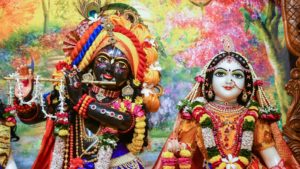
“Srila Prabhupada, being a visionary,” says Sanat-kumara Dasa, “could foresee the environmental imbalance coming in the next several decades, and he envisioned farm communities as effective outreach tools. People who would not otherwise visit a temple would visit farm communities and get an opportunity to get spiritual wisdom.”
Animal care: About 108 cows and bulls, along with a few goats, sheep, donkeys and dogs, happily reside at GEV in the loving care of its residents, especially Sri Nandanandana Dasa.
Radhanath Swami says, “Cow protection is the foundation of what we represent. Cow protection is not just to not slaughter the cows, but to make them happy from the moment they are born till they naturally leave their bodies.”
To uphold these principles, a magnificent goshala, with an array of facilities for cows, was built on three and a half acres close to the foothills of Mt. Kohoj.

Organic farming: Under the guidance and supervision of Sanat-kumara Dasa, the agriculture team strives to set an example of growing food in an environment-friendly way by employing innovative and traditional technologies, including crop rotation, companion planting, and chemical-free fertilizers. A plant nursery on three acres boasts hundreds of varieties of flora.
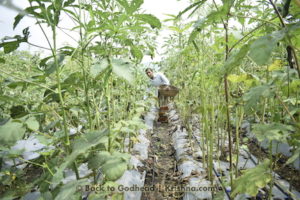
Water conservation and waste management: Water conservation involves harvesting rainwater, and water protection involves recharging the groundwater so that its quality isn’t contaminated by sewage. After a thorough hydrogeological survey, GEV identified locations for water bodies and implemented green sewage-management technologies. They include a soil biotechnology plant that processes up to thirty thousand liters of sewage daily, recycling up to ten million liters of water annually. For all these efforts, led by Gauranga Dasa, Vasudeva Dasa, and Ganga Narayana Dasa, GEV has won several awards.

“Having achieved one hundred percent recovery or recycling of water at GEV,” says Vasudeva Dasa, “we would like to focus on harvesting every drop of water that falls here. We are also planning to double the production of solar electricity.”
Outreach: Under the direction of Rupa Raghunatha Dasa, GEV holds regular satsanga programs in more than fifty villages nearby. Hundreds of villagers have taken to bhakti and visit the temples at the GEV during festivals like Janmashtami and special programs like Jagannatha Rathayatra.

Education: Bhaktivedanta Vidyapitha Research Centre (BVRC) at GEV provides systematic training in bhakti scriptures through full-time residency, part-time and online courses, and various publications, such as the Subodhini series (www.vidyapitha.in). The Vidyapitha is affiliated with the University of Mumbai.
GEV also conducts regular courses for farmers and yoga teachers, and runs English and Marathi schools for rural children.
Rural development: GEV also inspires and assists local farmers to take to organic farming. And apart from doing chemical-free agriculture, these farmers also take up Krishna consciousness. GEV is also active in empowering women, in rural health care, and in free-food distribution to thirty thousand school children.
Other significant projects at GEV include alternative energy (solar) and the manufacture of natural products and cow products under the brand name Eco Oasis.
The First Stone Temple
On April 14, 2014, a beautiful stone temple was inaugurated at GEV with the presiding deities of Sri Sri Radha–Vrindavana-Behari. Vrindavana-Behari is a name of Lord Krishna denoting His playful wandering in the Vrindavan forest along with His intimate friends, especially Srimati Radharani, the personification of devotion. The gorgeous deity of Krishna is the first black marble deity in the Mumbai area. And the temple, made of pink sandstone in fine Rajasthani-style architecture, is ISKCON’s first stone temple.

Mahabhagavata Dasa, an artist and resident brahmachari at GEV, was instrumental in fashioning the exquisite forms of Sri Sri Radha–Vrindavana-Behari. From sketching Them on paper to giving Them Their final shapes, including Their expressions and the precise proportions of Their limbs, he directed the carvers in Jaipur. At the same time, Anupama Gauranga Dasa, another brahmachari artist, oversaw the carving of the stones for the temple. Manamohana Dasa supervised the intricate carving of the incredible wooden altars of the deities and Srila Prabhupada and also the making of the huge circular temple hall. And with the efforts of many devotees under the expert leadership of Gauranga Dasa, the magnificent thirty-foot-high stone temple manifested within the very short time of less than a year.
The temple is a fine example of the rich traditions of Indian architecture. Experienced Rajasthani architects designed the temple, and an architect from Bayana had the stones intricately carved. For the outer walls of the temple, expert artisans in Orissa elaborately shaped detailed carvings of prominent scenes from all twelve cantos of Srimad-Bhagavatam and from Lord Krishna’s Vrindavan pastimes. While circumambulating the temple, one is enlivened and enlightened to see and discuss these eternal pastimes etched in stone.

Another exciting feature of the temple is a huge carved stone placed as the roof at the entrance. It is in the shape of Srimati Radharani’s candrika, the crescent-moon-shaped ornament She wears on Her head. It weighs five tons, and ten people took six months to intricately carve the loops of candrikas on it. It was placed in its position after the temple was inaugurated. According to shilpa shastras (scriptures on architecture), the piece is called a kalpa-vriksha, after the desire-fulfilling tree of the spiritual world.
Two years after the temple’s inauguration, in 2016, a white marble deity of Lord Sri Gauranga (Chaitanya Mahaprabhu) was installed next to Sri Sri Radha–Vrindavana-Behari. The deities are lovingly worshiped by the residents of GEV with fine natural ingredients. All the major Vaishnava festivals are grandly celebrated. It’s an out-of-this-world experience for visitors to GEV to have the darshana of the deities gorgeously decorated with local forest flowers.
Vrindavan: Forest of Grace
Surcharging the eco-friendly ambience of GEV with spiritual vibrations is a ten-acre replica of Lord Krishna’s Vrindavan village. Vrindavan Forest is the heart of GEV. For about four decades, Radhanath Swami had longed to re-create Vrindavan in this way.
“The Vrindavan Forest at Govardhan Ecovillage is a place to absorb ourselves in the remembrance of original Vrindavan in feelings of separation,” says Radhanath Swami, defining its purpose.
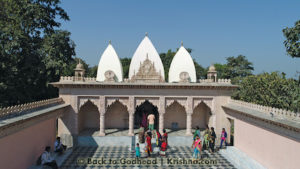
Hosting Vrindavan’s twelve main forests, nine major temples, the Yamuna River, Govardhan Hill, and many diorama exhibits depicting various pastimes of Lord Krishna, this replica of Vraja (Vrindavan) gives its visitors a distraction-free spiritual experience. The resident devotees regularly go for Vraja-parikrama (a devout walk around Vraja), especially in the month of Karttika.
Vrindavan Forest includes scaled-down red-sandstone-clad versions of the main temples of Vrindavan: Radha-Govindaji, Radha–Madana-Gopala, Radha-Ramana, Radha-Syamasundara, Radha Damodara, Radha Gokulananda, and Radha Gopinatha. The dimensions of these versions were meticulously worked out by Mahabhagavata Dasa and his team, and the construction was overseen by Anupama Gauranga Dasa and Braja Govinda Dasa. The beautiful landscaping of the entire ten acres was coordinated and supervised by Aloka Nimai Dasa and Madhava Gaura Dasa.

Later, Sriji Mandir of Barsana and Nanda Bhavan of Nandagram were built at well-chosen locations. The Sriji temple gives a spellbinding view of Mount Kohoj, and its courtyard offers a perfect peaceful ambience for satsangas and congregational kirtanas. Large framed photos of the original deities of Vrindavan are placed in these temples, and aratis and meals are offered daily.
Inside the Radha-Damodara temple are replicas of Srila Prabhupada’s room and kitchen at the Radha-Damodara temple in Vrindavan. There are also the bhajana-kutir and samadhi of Srila Rupa Goswami. This charming area with cow-dung flooring offers a wonderful setting for spiritual discussions and meetings.
Smaller temples of Kushalbihariji, Man-mandir, Mor-kutir, Gopeshvara Mahadeva, Banke-Behari, Radha-Vallabha, and others, along with samadhis of various Vaishnava acharyas, are present in either stone or wood. Natural sitting places with stone and wooden benches are available in various places so that visitors can meet, chat, chant, and meditate.
The enchanting Yamuna River at Keshi-ghata attracts residents and visitors at sunset for a daily arati. Yamunashtakam, a devotional song by Srila Rupa Goswami glorifying the Yamuna River, is sung during the arati. In this Yamuna, Sri Sri Radha-Ban-Behari, the festival deities of the main temple, enjoy a boat festival and water games.
Govardhan Hill was made by assembling hundreds of huge boulders, many weighing over five tons. Surrounding the hill are Aniyor-kshetra, Govinda-kunda, Madhavendra Puri Baithak, Apsara-kunda, Naval-kunda, Lota-baba Mandir, Vallabhacharya Baithak, Surabhi-kunda, Manasa Ganga, Harideva Mandir, Raghunatha Dasa Goswami Samadhi, Jahnava Mataji Baithak, Radha-kunda, and Syama-kunda. On the banks of Radha-kunda a shila (stone) of the original Govardhan is worshiped. Govardhan Puja is a major festival celebrated at GEV. Hundreds of food preparations are lovingly offered to Giriraja (Govardhan) while hundreds of devotees offer Him prayers and circumambulate the hill. A Vaishnava memorial on the bank of Syama-kunda honors recently departed Vaishnavas.

Vrindavan Forest, with its natural stone temples, sand pathways, flowering plants, soothing water bodies, and sweetly chirping birds in the green trees and groves moves visitors’ hearts, leaving a lasting transformative impression. Devotees conduct guided tours of Vrindavan Forest every day and special retreats during weekends, festivals, and holidays. Daily yajnas (fire sacrifices) are conducted in the yajna-shala (yajna building).
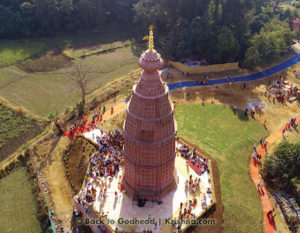
Madana-mohan Magnificence
In 1997, when Radhanath Swami became ISKCON’s governing body commissioner for New Vrindaban in West Virginia, the first thing he wanted was to build a Madana-mohana temple.
“I became a devotee in Vrindavan,” he recalled one day. “When I was in New Vrindaban, I had a serious fear that I would forget my experiences in Vrindavan, because they were so deeply sacred to me. So every single day for nine years, before eating I would go for Vrindavan parikrama for twenty minutes in my meditation. I would remember my life in Vrindavan in each place. I would visualize standing by the Yamuna and offering oblations toward the Madana-mohana temple.”
In 1999 Radhanath Swami asked one of his disciples, Jaya Gopala Dasa in Pune, then a civil engineering student, to study old stone structures. Radhanath Swami wanted a full-size replica of the original Madana-mohana temple to be built at GEV. Jaya Gopala made detailed layouts of the original Madana-mohana temple, and they were used to make the temple at GEV.
The foundation of the temple is fourteen feet deep. Huge red stones carved by Indra Acharya’s team from Bayana were transported to GEV. Assembling stones of a few tons each to make the hundred-foot-high monument was not an easy task. It took months of work with cranes and other heavy equipment.

Braja Govinda, who coordinated and supervised the construction, shares his experience.
“As the height increased, the difficulty in transferring the stones increased. The scaffolding around the structure had to be very sturdy. But by the grace of Madana-mohanaji and the prayers of Radhanath Swami, the entire construction went smoothly without any major accidents.”
As the temple was getting ready inch by inch to resemble its original counterpart, Mahabhagavata and his team researched making replicas of the original Madana-mohana deities, now worshiped in Karoli, Rajasthan. In Karoli they met reporters, writers, temple guards, temple managers, and local people, but no one had a close-up image or measurements of the deities, as no photography is allowed inside the temple. Finally, the temple manager appointed Sriman Anup Chakravarti, the chief priest of the temple, as a point of contact for the team. With his kind help they got an idea of the original forms of Radha–Madana-mohanaji and Lalita Devi. Thus after a few trials and rejections, a black marble deity of Lord Madana-mohana was carved in Mahabalipuram, Tamil Nadu, and brass deities of Srimati Radharani and Srimati Lalita Devi were made in Kumbakonam, also in Tamil Nadu.
The magnificent temple was inaugurated on January 25, 2019. It sits between the Radha-Vrindavana-Behari temple and the Vrindavan Forest, on a grass-covered hill that resembles Dvadashaditya Tila in Vrindavan, the site of the original temple. From there one gets a wonderful view of Mount Kohoj to the east. Amid fields, forests, and a village ambience, the temple charms the hearts of devotees and visitors alike.

Anup Chakravati, the chief priest of Madana-mohana in Karoli, told Radhanath Swami, “The Madana-mohana deities are in Karoli, and the Madana-mohana temple is in Vrindavan. In GEV you have brought them together.”
Unity of Hearts and Hands
GEV is a loving offering to Srila Prabhupada by Radhanath Swami and his devoted disciples. The project wouldn’t have developed to the extent it has in a short time without the kind wishes and blessings of Vaishnavas and the generous contributions of many devotees in the congregation of ISKCON Chowpatty. And the progress wouldn’t have been possible without the selfless background support of GEV’s resident devotees.

Sitting in the lap of mother nature, surrounded by mountains, with the Vaitarna River flowing nearby, Govardhan Ecovillage offers an ideal setting to experience the sweetness of bhakti-yoga. GEV has received dozens of awards, hosted hundreds of events, and attracted thousands of visitors every year.

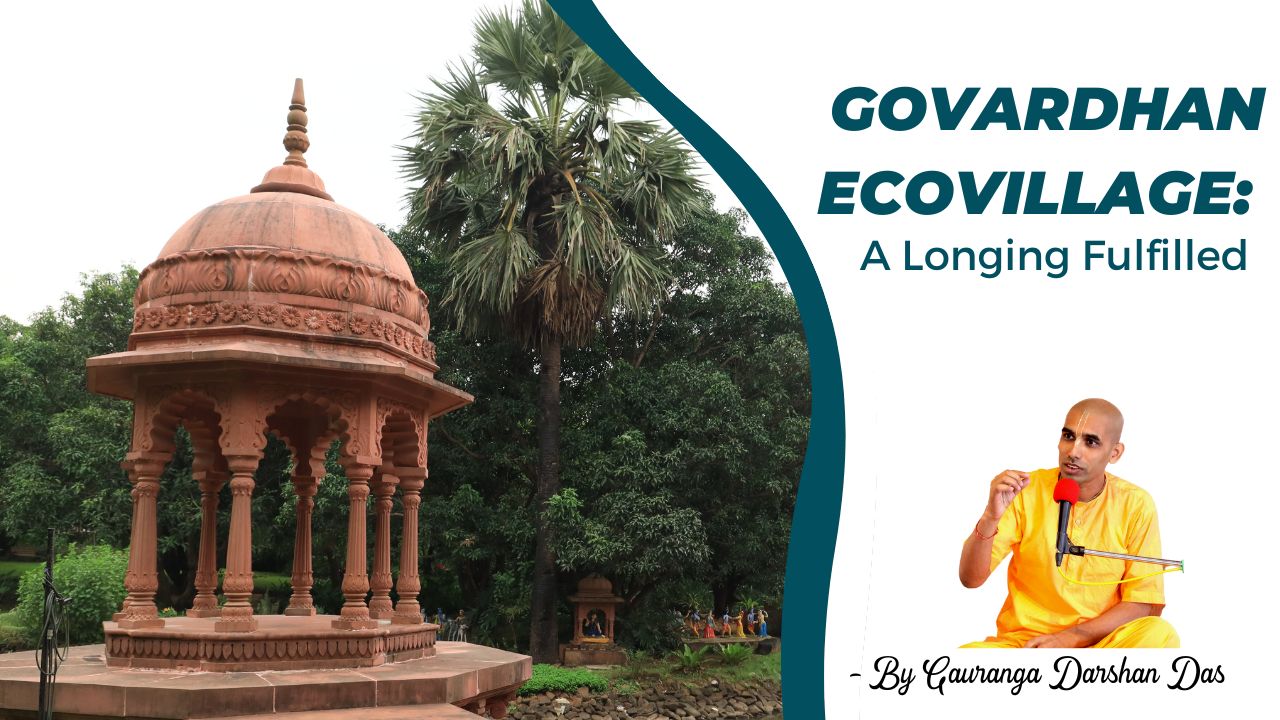



Can girls too allowed to be like monk